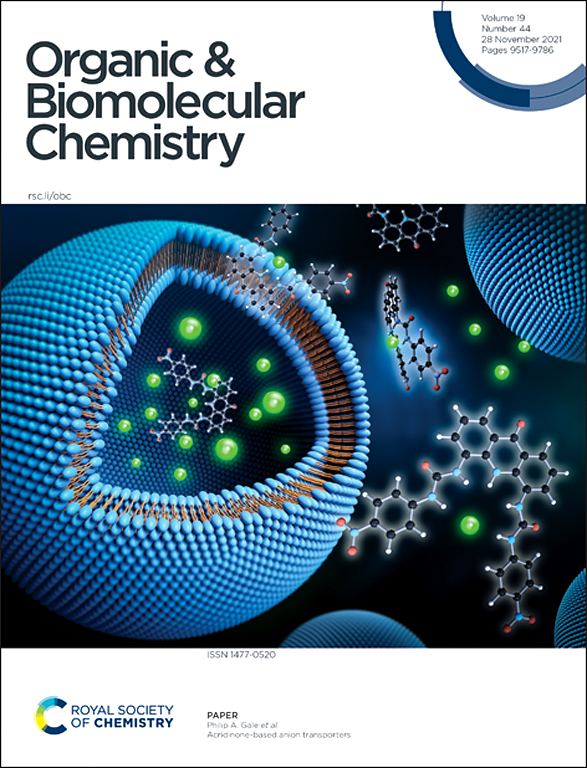涉及葡萄糖基硝基酮的[3 + 2]环加成的机理和立体选择性:MEDT研究。
IF 2.7
3区 化学
Q1 CHEMISTRY, ORGANIC
引用次数: 0
摘要
本研究运用分子电子密度理论(MEDT)研究了C-(d -葡萄糖)- n -甲基硝基酮1与1h -吡咯-2,5-二酮2之间的[3 + 2]环加成反应(32CA)的反应机理和实验观察到的立体选择性。在概念DFT (CDFT)框架内,2表现为亲电试剂,而1表现为亲核试剂。键演化理论(BET)分析表明,32CA反应是通过一步异步机制进行的,其中C3-C4键的形成先于O1-C5键的形成,并沿内端和外端途径进行。基于电子局域函数(ELF)和分子原子量子理论(QTAIM)的分析进一步支持了这种异步性质,证实了分别没有新的失配盆地(V(C3,C4)和V(O1,C5))和新的共价键。总的来说,内通道在热力学和动力学上都比外通道有利。最后,利用畸变/相互作用-激活应变模型,我们证明了观察到的内/外选择性主要由相互作用能的差异决定。此外,分子对接分析显示,该末端产物与1CIN蛋白酶具有相当大的结合亲和力,表明其作为治疗抑制剂的潜力。此外,药物相似性评估证实,化合物坚持利平斯基的规则五,标志着有利的药代动力学特征。本文章由计算机程序翻译,如有差异,请以英文原文为准。
Mechanism and stereoselectivity of a [3 + 2] cycloaddition involving a glucosyl nitrone: a MEDT study†
In this study, Molecular Electron Density Theory (MEDT) is employed to investigate the reaction mechanism and the experimentally observed stereoselectivity of the [3 + 2] cycloaddition (32CA) between C-(d-glucoso)-N-methyl nitrone and 1H-pyrrole-2,5-dione . Within the Conceptual DFT (CDFT) framework, behaves as an electrophile, while acts as the nucleophile. Bonding Evolution Theory (BET) analysis reveals that this 32CA reaction proceeds through a one-step asynchronous mechanism, where the formation of the C3–C4 bond occurs before that of the O1–C5 bond along both the endo and exo pathways. This asynchronous nature is further supported by analyses based on the Electron Localization Function (ELF) and the Quantum Theory of Atoms in Molecules (QTAIM), which confirm the absence of new disynaptic basins (V(C3,C4) and V(O1,C5)) and of new covalent bonds, respectively. Overall, the endo pathway is found to be both thermodynamically and kinetically more favorable than the exo pathway. Finally, using the distortion/interaction–activation strain model, we demonstrate that the observed endo/exo selectivity is primarily governed by differences in interaction energies. Moreover, molecular docking analyses revealed that the endo product has considerable binding affinity to the 1CIN protease, indicating its potential as a therapeutic inhibitor. Moreover, drug-likeness evaluations verified that the compounds adhere to Lipinski's rule of five, signifying advantageous pharmacokinetic characteristics.
求助全文
通过发布文献求助,成功后即可免费获取论文全文。
去求助
来源期刊

Organic & Biomolecular Chemistry
化学-有机化学
CiteScore
5.50
自引率
9.40%
发文量
1056
审稿时长
1.3 months
期刊介绍:
Organic & Biomolecular Chemistry is an international journal using integrated research in chemistry-organic chemistry. Founded in 2003 by the Royal Society of Chemistry, the journal is published in Semimonthly issues and has been indexed by SCIE, a leading international database. The journal focuses on the key research and cutting-edge progress in the field of chemistry-organic chemistry, publishes and reports the research results in this field in a timely manner, and is committed to becoming a window and platform for rapid academic exchanges among peers in this field. The journal's impact factor in 2023 is 2.9, and its CiteScore is 5.5.
 求助内容:
求助内容: 应助结果提醒方式:
应助结果提醒方式:


